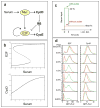Dynamic modelling of oestrogen signalling and cell fate in breast cancer cells
- PMID: 21677677
- PMCID: PMC3294292
- DOI: 10.1038/nrc3081
Dynamic modelling of oestrogen signalling and cell fate in breast cancer cells
Abstract
Cancers of the breast and other tissues arise from aberrant decision-making by cells regarding their survival or death, proliferation or quiescence, damage repair or bypass. These decisions are made by molecular signalling networks that process information from outside and from within the breast cancer cell and initiate responses that determine the cell's survival and reproduction. Because the molecular logic of these circuits is difficult to comprehend by intuitive reasoning alone, we present some preliminary mathematical models of the basic decision circuits in breast cancer cells that may aid our understanding of their susceptibility or resistance to endocrine therapy.
Figures






References
-
- Hanahan D, Weinberg, Robert A. Hallmarks of Cancer: The Next Generation. Cell. 2011;144:646–674. - PubMed
-
- Hornberg JJ, Bruggeman FJ, Westerhoff HV, Lankelma J. Cancer: a Systems Biology disease. Biosystems. 2006;83:81–90. - PubMed
-
- Faratian D, Moodie SL, Harrison DJ, Goryanin I. Dynamic computational modeling in the search for better breast cancer drug therapy. Pharmacogenomics. 2007;8:1757–61. - PubMed
-
- Novak B, Pataki Z, Ciliberto A, Tyson JJ. Mathematical model of the cell division cycle of fission yeast. Chaos. 2001;11:277–286. - PubMed
Publication types
MeSH terms
Substances
Grants and funding
LinkOut - more resources
Full Text Sources
Other Literature Sources
Medical

